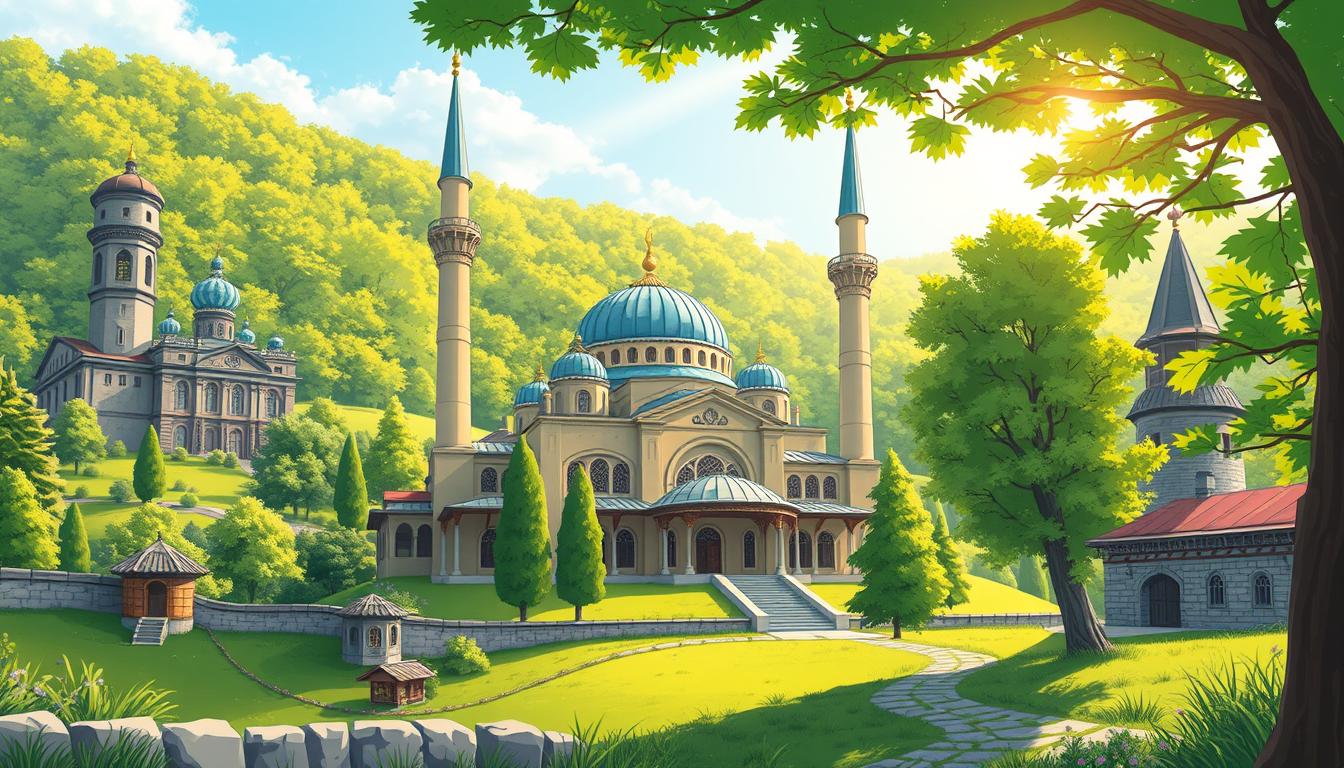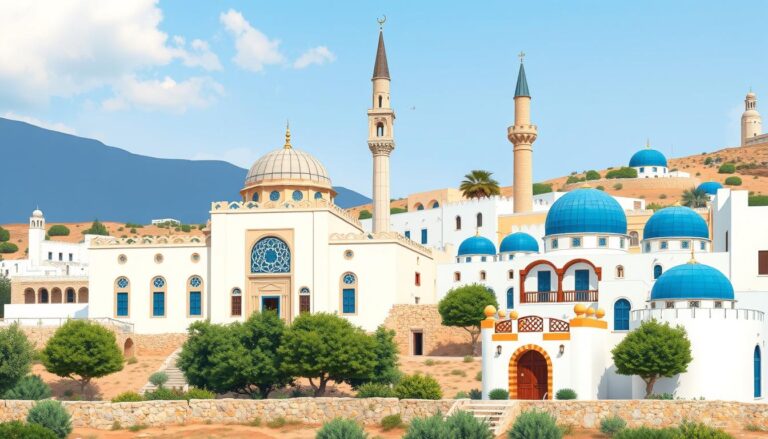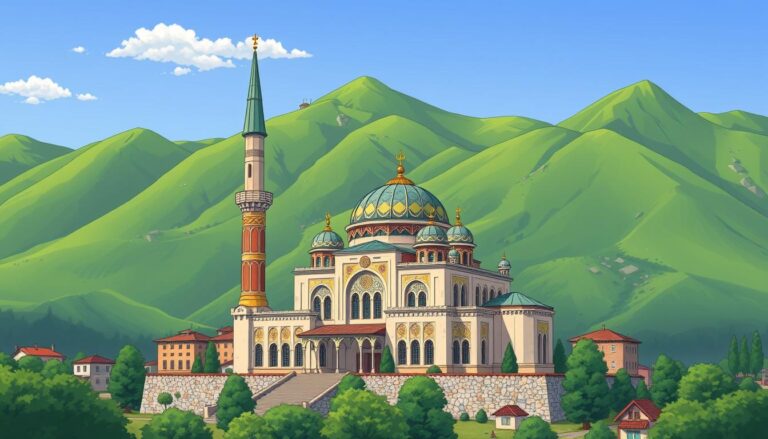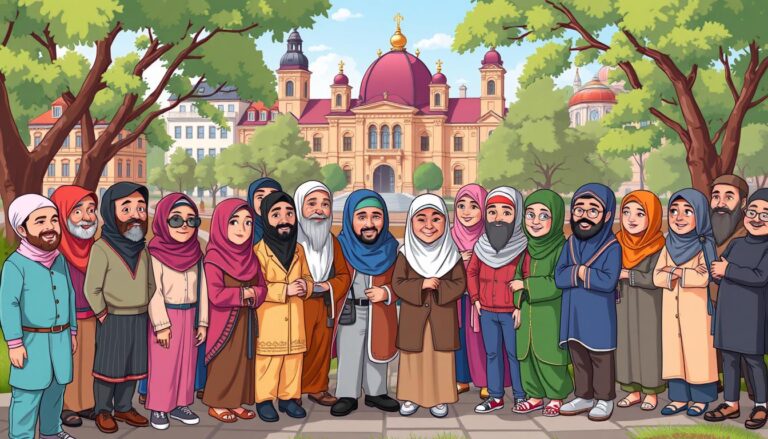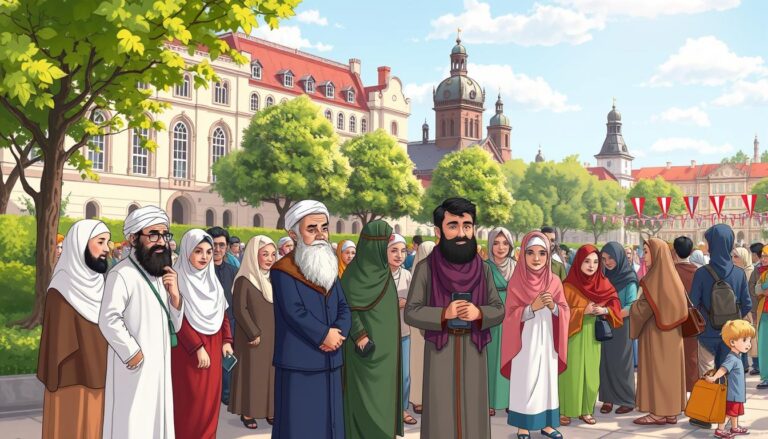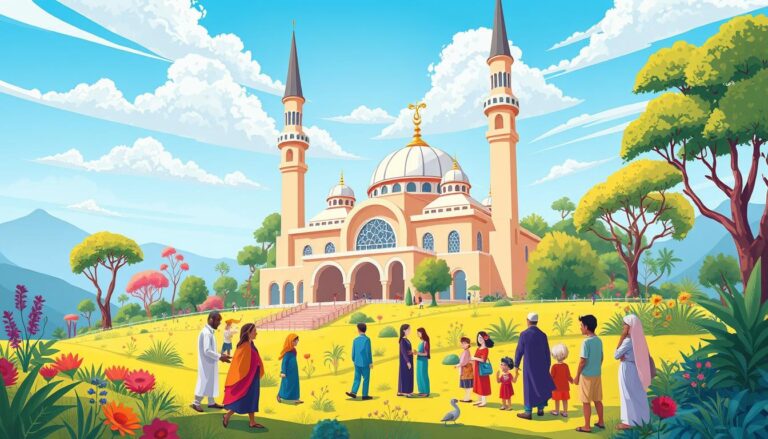Islam in Ukraine
Despite Islam representing only around 5% of Ukraine’s total population, the religion has a long and significant history in the country, dating back to the 13th century and the establishment of the Crimean Khanate in the 15th century. Ukraine’s Muslim community includes Ukrainians, Crimean Tatars, and people from various Muslim-majority countries who have integrated into Ukrainian society over the centuries, leaving an indelible mark on the region’s culture, architecture, and way of life.
Key Takeaways
- Islam is a minority religion in Ukraine, representing around 5% of the total population.
- The history of Islam in Ukraine dates back to the 13th century and the establishment of the Crimean Khanate.
- Ukraine’s Muslim community includes Ukrainians, Crimean Tatars, and immigrants from Muslim-majority countries.
- Islam has left a lasting impact on Ukraine’s culture, architecture, and way of life.
- The role of Islam in Ukrainian society continues to evolve, with both challenges and opportunities for the Muslim minority.
Introduction to Islam in Ukraine
Ukraine has a rich and diverse religious landscape, with Islam playing a significant role in shaping the country’s cultural heritage. The Muslim population in Ukraine is estimated to be around 1.5 million, comprising a diverse group of Ukrainians, Crimean Tatars, and individuals from Muslim countries who have integrated into Ukrainian society.
Overview of the Muslim Population in Ukraine
The history of Islam in Ukraine dates back centuries, with the establishment of the Crimean Khanate, an Islamic state that existed from the 15th to 18th century. This period left a lasting Islamic influence in Ukraine, both politically and culturally. Today, Ukraine’s Muslim population is primarily concentrated in the Crimean Peninsula, Kyiv, and other major cities.
Significance of Islam in Ukrainian Society and History
Islam has played a crucial role in shaping Ukrainian society and history. In the 18th century, there were 18 mosques and numerous educational establishments in Bakhchisarai, the capital of the Crimean Khanate. Furthermore, in 1917, Muslims comprised one-third of the Crimean population and 11% of urban residents. The Islamic influence in Ukraine has contributed to the country’s cultural diversity and religious landscape, making it an integral part of Ukraine’s identity.
“Ukraine has a rich and diverse religious landscape, with Islam playing a significant role in shaping the country’s cultural heritage.”
Despite the historical significance of Islam in Ukraine, the Muslim community has faced various challenges, including discrimination, intolerance, and legal and social barriers. However, the resilience and adaptability of Ukrainian Muslims have allowed them to maintain their traditions and contribute to the cultural fabric of the country.
Historical Overview of Islam in Ukraine
The early history of Islam in Ukraine traces back to the interactions between the ancestors of modern Ukrainians and the Muslim world. The Kievan Rus’, the medieval East Slavic state, had early contacts with the Muslim world, including a campaign by Prince Volodymyr of Kyiv to Bulgar in 985, where Islam was the state religion. The presence of Muslims in Kievan Rus’ is also documented in the 11th century, with reports of Muslim Pechenegs serving in the prince’s cavalry.
Early interactions with the Muslim world
Arab traders visited the south of Ukraine since the Abbasid Caliphate times around the Sea of Azov, Kherson, and other areas. Ukraine became essentially a Muslim-ruled country after Berkai Khan’s conversion to Islam in 1258. By the 1330s, three of the four major Mongol Khanates had become Muslim.
Establishment of the Crimean Khanate
The Crimean peninsula became the main area for the spread of Islam in the lands that are now part of independent Ukraine, and it was here that the Crimean Tatar civilization was born and strengthened, with Islam as the state religion of the Crimean Khanate. The Ozbek Han Mosque, constructed in 1314, is recorded as the oldest mosque in Crimea.
“The presence of Islam was almost non-existent in Ukraine from the late 1940s, with approximately 40,000 Muslims living in the country at that time.”
Under Catherine of Russia, Masjids in Ukraine were destroyed as Russians were brought in and the landscape changed. However, Muslims in southern Russia and Ukraine resisted Russian invasions valiantly, maintaining their presence to this day.
The revival of Islam in Ukraine post-communism has led to large percentages of Muslims in annexed regions like Crimea (2014), Donetsk, and Luhansk. Today, Ukraine has 400 active Salaah places, including 200 Masjids, with another 100 under construction.
The Crimean Khanate: A Golden Age of Islam
The Crimean Khanate, which lasted for over 300 years, was a remarkable period of thriving Islamic civilization in the region. Under the influence of the Crimean Khanate, the national culture of the Crimean Tatars, including their language, traditions, system of education, and upbringing, was shaped by Islamic norms and ideas.
During this golden age, the Crimean Peninsula witnessed a remarkable development of Muslim architecture. Impressive monuments such as the Uzbek and Beybarsa mosques, the Kurshum-Jami and Takhtala-Jami mosques, madrasahs, caravanserais, and fountains, adorned the landscape, showcasing the vibrant Islamic culture that flourished in Crimea.
The administrative center of the Khanate, Bakhchisarai, was a veritable treasure trove of Islamic heritage. The city was home to a grand palace, numerous mosques, and a rich collection of Muslim literature from the Middle Ages, further testament to the prominent role of Islam in the region.
“The Crimean Khanate was a remarkable period of thriving Islamic civilization in the region, leaving a lasting imprint on the culture, architecture, and intellectual life of Crimea.”
The Crimean Khanate’s legacy continues to shape the cultural identity of the Crimean Peninsula, serving as a testament to the enduring influence of Islamic civilization in Crimea and the Muslim architecture and culture that flourished during this Crimean Khanate period.
Islam in Ukraine: The Modern Era
The 20th century marked a tumultuous time for Muslims in Ukraine, particularly the Crimean Tatars. In 1944, on the orders of Stalin, the entire Crimean Tatar population was deported to Central Asia, with thousands losing their lives during the forced relocation. The Crimean Tatars were denied the right to return to their homeland until the late 1980s.
However, after Ukraine gained independence in 1991, Islam experienced a resurgence. The Crimean Tatars and other Muslim communities began rebuilding their religious and cultural institutions, reclaiming their rightful place in Ukrainian society. This renewed sense of identity and community was a testament to the resilience of the Crimean Tatar people.
Deportation of the Crimean Tatars
The deportation of the Crimean Tatars in 1944 was a devastating blow to the Muslim community in Ukraine. Falsely accused of collaborating with the Nazis, the Crimean Tatars were forcibly removed from their ancestral homeland and sent to remote regions of Central Asia. This dark chapter in history left an indelible mark on the Crimean Tatar psyche, but their determination to preserve their cultural heritage never wavered.
Resurgence of Islam after Ukrainian Independence
The collapse of the Soviet Union and Ukraine’s independence in 1991 ushered in a new era for the country’s Muslim population. With the shackles of oppression lifted, Crimean Tatars and other Muslim communities were able to revive their religious and cultural institutions. Mosques were rebuilt, Islamic schools were established, and the Crimean Tatar language and traditions were once again celebrated openly.
This resurgence of Islam in modern Ukraine was a testament to the resilience and adaptability of the Muslim community. Despite the challenges they faced, from the deportation to the ongoing conflict in Crimea, the Crimean Tatars and other Ukrainian Muslims have demonstrated their unwavering commitment to preserving their faith and identity.
“The Crimean Tatars have faced immense challenges, but their spirit remains unbroken. Their story is a testament to the strength and perseverance of the Muslim community in Ukraine.”
Prominent Islamic Figures and Institutions in Ukraine
Ukraine’s Muslim community is represented by several prominent Islamic leaders and organizations. The Religious Administration of Muslims of Ukraine (RAMU) “UMMA” and the All-Ukrainian Association of Social Organisations “ALRAID” are two of the largest Islamic institutions that have played a pivotal role in promoting moderate Islam and supporting Muslims in the country.
RAMU “UMMA” was established on September 11, 2008, in Kyiv, Ukraine. It coordinates the activities of Muslim communities in 17 regions, including Kyiv, Donetsk, and Crimea. RAMU “UMMA” organizes elections for the Mufti and a Board of 7 persons every 2 years, and it has engaged in educational initiatives such as organizing International Summer Schools for Islamic Studies.
In addition to its educational efforts, RAMU “UMMA” has its own printed periodical, the religious and educational paper “Ummah,” and it has participated in international interreligious dialogues focused on European Christians and Muslims, promoting mutual understanding. The Chairman of the Board of RAMU “UMMA” is Oleh Huzyk, and the Mufti is Said Ismagilov.
Another prominent Islamic organization in Ukraine is the All-Ukrainian Association of Social Organisations “ALRAID”. ALRAID has faced challenges, including searches by security forces and persecution of its leaders, particularly in the occupied territories of Crimea and Donbas. Despite these obstacles, the organization continues to serve the Muslim community and advocate for the rights and freedoms of Ukrainian Muslims.
These Islamic leaders in Ukraine and Muslim organizations in Ukraine play a crucial role in preserving the rich cultural heritage and religious traditions of the country’s Muslim population, while also promoting interfaith dialogue and social integration.
Islam in Ukraine
Islam has a long and rich history in Ukraine, with a presence dating back to the 13th century. The Muslim population in Ukraine, estimated at around 1.5 million, is composed of various groups, including Ukrainians, Crimean Tatars, and individuals from Muslim countries who have integrated into Ukrainian society.
The Crimean Khanate, a golden age of Islam in Ukraine, greatly influenced the country’s culture, architecture, and societal structure. During this period, an atmosphere of religious tolerance was maintained, allowing the coexistence of various faiths, including Christian denominations, within the state.
Islamic culture has left a lasting impact on Ukraine, shaping the national culture, traditions, language, and arts of the Crimean Tatar people. The first mosque in Ukraine was built in the 16th century by Prince Konstantin Ostrogski in Ostroh for Muslims in his service.
While the level of Islamophobia is generally low in Ukraine, Ukrainian Muslims have faced some challenges, such as discrimination, legal barriers, and persecution in the occupied territories of Crimea and Donbas.
Despite these challenges, Islam continues to play a significant role in Ukrainian society. The holy month of Ramadan, for instance, has become a period of unity among both Muslims and all Ukrainians, with the Ukrainian Muslimahs League organizing iftar meals and providing aid to those in need.
“Ramadan has become a period of unity among both Muslims and all Ukrainians.”
The integration and coexistence of Muslims in Ukrainian society is an important aspect of the country’s cultural diversity and religious landscape.
Challenges Faced by Ukrainian Muslims
While Ukraine prides itself on its religious diversity, Ukrainian Muslims have faced various challenges in recent years. One of the primary issues is the discrimination and intolerance they have experienced from certain segments of the population.
Despite Ukraine’s legislation applying equally to all religious groups, Muslim religious communities have reported difficulties in securing land allocations for building mosques, Islamic centers, and cemeteries. This has hindered their ability to freely practice their faith and establish necessary community infrastructure.
Furthermore, Muslim women wearing hijabs have encountered difficulties in securing employment, with some employers refusing to hire them or asking them to remove their headscarves. This legal and social barrier has made it challenging for Muslim women to participate fully in the workforce and society.
The occupation of Crimea and parts of Donbas has also led to the persecution of Muslim leaders and the closure of religious organizations in these regions. This has further exacerbated the challenges faced by Ukrainian Muslims, disrupting their ability to practice their faith and maintain their cultural heritage.
As Ukraine continues to navigate its path towards greater inclusivity and religious freedom, addressing the discrimination against Muslims and overcoming the legal and social barriers they face will be crucial in ensuring the rights and well-being of this important community.
Cultural Contributions of Ukrainian Muslims
The presence of Islam in Ukraine has had a profound impact on the country’s cultural landscape. During the era of the Crimean Khanate, the national culture of the Crimean Tatars, including their language, traditions, and educational system, was heavily influenced by Islamic norms and ideas. This period saw the flourishing of Muslim architecture, with numerous mosques, madrasahs, caravanserais, and other structures showcasing the region’s vibrant Islamic heritage.
The Crimean Tatar culture has also left an indelible mark on art, literature, and music, contributing to the rich diversity of Ukraine’s cultural expression. Muslim influence on Ukrainian culture and the Islamic contributions to the country’s art and architecture have been significant and enduring.
“The Crimean Tatars have been an integral part of Ukraine’s history for centuries, and their cultural legacy continues to shape the nation’s identity.”
Today, Ukraine’s Muslim communities, particularly the Crimean Tatars, Ukrainians, and individuals from Muslim countries who have settled in Ukraine, maintain strong ties to their Islamic heritage and contribute to the country’s diverse cultural fabric. As Ukraine continues to navigate the challenges of the Russian-Ukrainian war, the role of its Muslim communities in preserving and celebrating the nation’s cultural richness remains crucial.
Integration and Coexistence of Muslims in Ukrainian Society
Despite the challenges faced by Ukrainian Muslims, the country has generally maintained a relatively low level of Islamophobia, enabling Muslims to integrate and coexist within Ukrainian society. The Muslim population in Ukraine, which includes both long-established communities and more recent arrivals, has been able to practice their faith, build mosques, and participate in the country’s civic and cultural life.
While there have been isolated incidents of intolerance, the Ukrainian government has generally upheld the principles of religious freedom and equality, allowing Muslims to maintain their traditions and contribute to the cultural diversity of the nation. Organizations like the Association of Muslims of Ukraine (AMU) and the Religious Administration of Muslims of Ukraine (RAMU) play a crucial role in consolidating and representing the interests of the Muslim community.
The coexistence of Muslims and non-Muslims in Ukraine is further reinforced by the presence of influential religious councils such as the All-Ukrainian Council of Churches and Religious Organizations (AUCCRO), which brings together various faith communities, promoting interfaith dialogue and understanding.
“The Muslim community in Ukraine has been able to thrive and contribute to the cultural fabric of the nation, despite the challenges they have faced. This is a testament to the country’s commitment to religious freedom and diversity.”
While the Muslim integration in Ukraine has not been without its complexities, the overall picture reflects a society that has largely embraced the diversity and richness that the Muslim population brings to the table. As Ukraine continues to navigate its path forward, the continued coexistence and integration of Muslims will be a crucial aspect of the country’s cultural and social landscape.
The Future of Islam in Ukraine
As Ukraine continues to navigate the challenges of the modern era, the future of Islam in the country remains uncertain but holds promise. The Muslim community in Ukraine has shown resilience in the face of persecution and displacement, and there are signs of a gradual increase in the acceptance and integration of Muslims within Ukrainian society.
However, the ongoing conflicts in Crimea and eastern Ukraine have brought new challenges for the Muslim population, particularly the Crimean Tatars. Muslims represent around 5% of the total population of Ukraine as of 2016, with the majority being Crimean Tatars, Sunni Muslims of Turkic origin.
Prospects for Growth and Acceptance
Despite the setbacks, the growth of the Muslim community in Ukraine is a positive trend. The Ukrainian military has witnessed a significant increase in Muslim soldiers joining after Russia’s annexation of Crimea in 2014, and there are efforts to provide them with the necessary support, such as halal food and religious chaplains.
Additionally, the interfaith dialogue in Ukraine has become increasingly important, with local imams and Muslim community leaders working to foster understanding and cooperation between different religious groups.
Fostering Interfaith Dialogue and Understanding
Moving forward, maintaining and strengthening these efforts to promote religious tolerance and create an environment that allows Ukrainian Muslims to thrive and contribute to the country’s cultural diversity will be crucial in shaping the future of Islam in Ukraine.
“The history of Islam in Ukraine is closely tied to the Crimean Khanate’s influence. The Crimean Khanate played a vital role in introducing Islam as the state religion in Crimea from 1313 to 1342.”
- Muslims represent around 5% of the total population of Ukraine as of 2016.
- Ukraine has a history with Islam dating back to the 13th century with the establishment of the Crimean Khanate in the 15th century.
- The first mosque that existed in Ukraine was built in the city of Ostroh in the 16th century under Prince Konstantin Ostrogski for Muslims in his service.
Conclusion
The story of Islam in Ukraine is one of resilience, adaptation, and the enduring spirit of a diverse community. From the early interactions with the Muslim world to the establishment and decline of the Crimean Khanate, Islam has been woven into the fabric of Ukrainian history and culture.
Today, Ukraine’s Muslim population, comprising approximately 1 million individuals, continues to navigate the challenges of the modern era. While the country has generally upheld the principles of religious freedom and equality, Ukrainian Muslims have faced discrimination, legal barriers, and the ongoing conflicts in Crimea and eastern Ukraine.
As Ukraine moves forward, the future of Islam in the country will depend on the ability to foster interfaith dialogue, promote tolerance, and create an environment that allows the Muslim community to thrive and contribute to the nation’s diverse cultural landscape. With the recent recognition of Crimean Tatars, Karaites, and Krymchaks as indigenous peoples of Ukraine, the Muslim community has gained a stronger voice and the right to self-governance and representation in the Ukrainian parliament.
Source Links
- Religion in Ukraine
- Ukraine Muslims pray for victory, end of occupation
- Islam and Hizb ut-Tahrir’s Activities in Crimea, Ukraine
- Muslims – RISU
- The History of Islam in Ukraine – British Muslim Magazine
- Islam in Ukraine
- Muslims in Crimea and the challenges of cultural legacy
- Islam in Crimea: golden past and uncertain present – RISU
- Crimean Khanate
- As bombs fall, Muslims in Ukraine face difficult Ramadan
- Islam in Ukraine: Then and Now, Past and Present – Arab America
- Islam in Ukraine
- Religious Administration of Muslims of Ukraine
- Ukrainian Muslims’ unique Ramadan traditions
- Islam in Ukraine
- Story #142. Ramadan During Wartime: Insights Into Ukraine’s Muslim Community
- Ukraine
- Jewish president picks Muslim defense minister: Ukraine’s diverse leadership debunks Russia’s “Nazi” slurs
- Religion and Forced Displacement in Ukraine – The Foreign Policy Centre
- URIS – Ukrainian Research in Switzerland. Ukraine Expertise Schweiz.
- Interview with Denys Brylov | Ukrainian Muslims fulfill diplomatic role, explaining the situation to their co-religionists in other countries
- No title found
- Islam and Muslims in Contemporary Ukraine: Common Backgrounds, Different Images
- The Ukrainian Muslims fighting against Russia
- Ukraine’s Muslim Military Chaplains Fight for Recognition
- Muslims in Ukraine Old History – New Challenges
- Ukraine – United States Department of State

